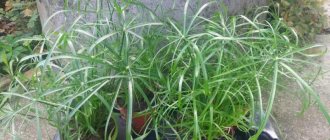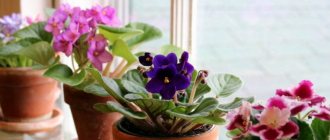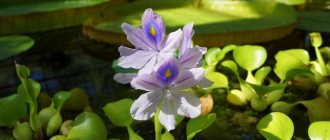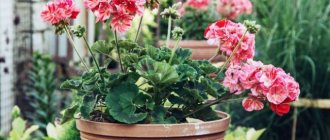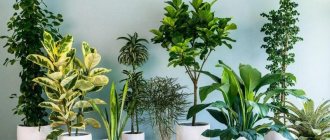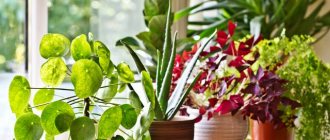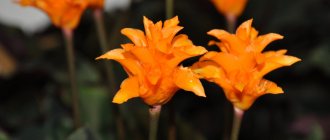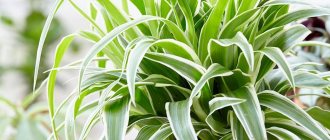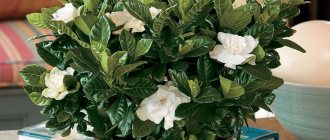We have prepared for you a selection of the most unpretentious large tub crops for home and office.
- Plants for bright rooms and those that can be placed next to panoramic windows Abutilon, indoor maple, rope plant, Abutilon
- Agave
- Ardisia, Ardisia
- Beaucarnea, Nolina, or bottle tree Beaucarnea, Nolina
- Washingtonia and other palms (Washingtonia)
- Heliconia, Heliconia
- Hibiscus, Chinese rose, or Chinese rose, Hibiscus
- Coffee, coffee tree, Arabica, Coffea
- Laurel, Laurus
- Oleander, Nerium
- Pachira, Malabar chestnut, Pachira
- Strelitzia, bird of paradise (Strelitzia)
- Citrus
- Aglaonema, Aglaonema
Spurge
Indoor spurge includes a group of plants that includes more than 2000 varieties. Brought from the island of Madagascar. Grows up to 1.5 meters.
The stem is single, with rough scars from fallen leaves visible on the surface. Euphorbia grows quickly and is prone to self-sowing. The leaves on the stem are arranged alternately in a spiral, have an ovoid shape, 15–20 cm in length, 6–8 cm in width. The front side is green with whitish veins, the back side is pale green in color.
Euphorbia juice is poisonous and, if ingested, causes severe poisoning. Therefore, it is better not to keep it in a house where there are children and animals.
What plants can live on the ceiling?
Home decor using stabilized plants is now gaining momentum. Outwardly, they cannot be distinguished from real ones - they are just as juicy, green, bright, and they look the same even up close.
Important! In fact, these are ordinary plants, but only the natural juice in them is replaced with a special solution, which allows them to maintain their original appearance for many years.
To grow a garden on the ceiling, the same plants are used as for arranging phytowalls: moss, flowers, deciduous representatives of the flora. Thanks to the preserved state, they stop growing, but also do not deteriorate, rot or wither.
Ceiling made of stabilized plants
Decorative moss is a very beautiful, luxurious plant for a ceiling garden. Usually it is used as a basis, background for various compositions. When decorating the ceiling with moss, the stasis room takes on a cozy look and gives a feeling of closeness to nature.
Other stabilized plants are also used in phytodesign of ceilings:
- boxwood, barberry;
- chrysanthemums, roses, magnolias;
- branches of fir, fir trees, etc.
Ficus
Ficus belongs to the mulberry family. There are over 900 plant species, including shrubs, vines, trees and banyan trees.
Popular types:
- ficus benjamina;
- rubbery;
- lyre-shaped;
- dwarf.
Unpretentious, outwardly different from each other, light-loving plants can reach 2–3 meters in height. They grow quickly, so they need to be replanted annually using special soil.
Lemon
Belongs to the category of evergreen plants. Loves temperatures of 10–22 °C, plenty of light, tolerates direct sunlight well. Watering should be done moderately, daily from May to September. You need frequent spraying and a warm shower in summer.
Varieties:
- The Meyer variety is low growing, early ripening with sour fruits.
- Kiev large-fruited - the fruits reach a weight of 1 kg.
- Pavlovsky - grows up to 2 m.
- Novogruzinsky remontant is a tall variety.
- Lisbon is vigorous and resistant to high temperatures.
Plants for bright rooms and those that can be placed next to panoramic windows
Abutilon, indoor maple, rope, Abutilon
Abutilon, or indoor maple, is a fairly large tub-shaped evergreen tree (up to 1.5 m tall) or shrub with maple-shaped leaves. It blooms from May to August with beautiful bell-shaped flowers, up to 5 cm in diameter. In summer, it can be placed outside, in places protected from strong winds.
In the decoration of premises, the plant is used both as a solitary plant and as part of compositions. In a winter garden, in a bright place, abutilon is very beautiful, where it can bloom almost all year round.
Indoor maple, or abutilon: which type to choose for growing at home?
hybrid abutilon, or indoor maple in the garden in summer
Agave
Agaves are perennial herbaceous rosette SUCCULENTS with a short stem and large, fleshy linear leaves, often with spines along the edges. A characteristic feature of agave plants is their huge inflorescences. Anavas bloom only once in their life, then they die.
For offices and halls, large adult specimens of American agave (Agave americana) are most often used, which in nature can reach a diameter of 3 m, in indoor culture rarely more than 1 m.
American agave grows well both at home and in cold greenhouses, where winter night temperatures range from +8 to +6 °C. Needs good lighting and some direct sunlight during the day, prefers the south side. In summer it is good to put it outside. Agave is unpretentious, but grows best in spacious pots.
Many southern guests, such as agaves (American agave in the center), dates, yuccas can be grown here too, but they need a lot of space
Ardisia, Ardisia
Ardisia crenate (Ardisia crenata) is an evergreen shrub up to 1.5 m tall with dark green leaves, small, undecorative flowers and bright orange-red fruits.
Place on a well-lit window, preferably a glazed loggia with a winter temperature of about +15 °C (up to +20 °C), summer temperature +20…+22 °C.
Ardisia crenate
Beaucarnea, Nolina, or bottle tree Beaucarnea, Nolina
Bocarnea, nolina, bottle tree - a tree up to 1.5 m high with a thickening at the base of the trunk and long narrow leaves at its top. Because of this base, the plant received the name "elephant's foot" in England, and because of the crown of various long leaves - "horse's tail".
A bright window with a moderate temperature regime is more suitable.
nolina, bocarnea or elephant's foot
Washingtonia and other palms (Washingtonia)
Palm trees decorate the interior very effectively, creating the impression of a real oasis of greenery. Especially if we are talking about large rooms in which pots with small plants are simply “lost.” These are some pinnate palms, whose leaves are shaped like a bird’s feather (coconut, date, howea, chamedorea, etc.). In fan-leaved or fan palms, the leaves are much shorter, but in some species they can reach up to 5 meters in width (Chamerops, Trachycarpus, Liviston palm, etc.).
Features of growing palm trees indoors
Livistona Rotundifolia, Howea, Chrysalidocarpus lutescens, Cycas
Heliconia, Heliconia
Heliconia is a perennial herbaceous plant with large leathery leaves and multi-tiered spike-shaped inflorescences. It grows as a beautiful bush and can become the center of your entire home.
Heliconia is very thermophilic. In a room with heliconia, high temperature and humidity must be constantly maintained, and the room must be well lit. Drafts are not allowed. A bright window, slightly shaded in summer, with a winter temperature of +18 °C, is suitable for placing heliconia.
Heliconia
Strelitzia is very similar to heliconia, but less demanding in cultivation. It is better to grow Strelitzia in offices.
Hibiscus, Chinese rose, or Chinese rose, Hibiscus
Hibiscus, Chinese rose, Chinese rose, swamp mallow, “flower of beautiful ladies” - evergreen trees or shrubs with large simple or double flowers of various colors (white, yellow, orange, lilac, all shades of pink and red, there are also two-color varieties).
Hibiscus - Chinese rose
Hibiscus: the most beautiful varieties and all the secrets of growing from collector Anna Kapanina
Chinese rose or hibiscus blooming
Coffee, coffee tree, Arabica, Coffea
Coffee, Arabica - an evergreen tree or bush, in indoor cultivation up to 1.5-2 m high. The plant is very unpretentious in cultivation, but requires a sunny place.
How to get a coffee harvest in your own apartment?
Coffee propagation by sowing and cuttings
How to grow coffee from seeds at home
You can not only grow coffee at home, but get a real harvest from it!
Laurel, Laurus
Laurel is an evergreen shrub with leathery, wavy-edged leaves containing essential oil. In phytodesign it is used as a solitaire or in group compositions. Usually cultivated as an ornamental tree with special pruning, for example with a spherical crown.
It grows well both in the sun and in the shade, but it branches better in the light. In winter, they are kept in a bright, well-ventilated room at a temperature of 0 to +14 °C.
Containers with laurel can be taken out into the garden for the summer and kept in a sunny place. Laurel is quite frost-resistant, so it can remain outdoors until late autumn.
Oleander, Nerium
Oleander is an evergreen shrub with beautiful flowers collected in racemes at the tops of the shoots. This is an excellent plant for decorating sunny, insulated loggias, winter gardens and greenhouses. In summer it can be taken out into the garden.
When kept in the garden in summer, a container with oleander is placed against the southern wall, in the warmest and sunniest place; in cool, rainy weather, flower buds develop poorly.
Oleander pruning
Oleander in nature and at home
Pachira, Malabar chestnut, Pachira
Pachira is a decorative indoor tree with leathery, palmate leaves, up to 1-2 m high, which has a special device for accumulating water in the trunk, which is where its name comes from. The leaves are leathery, palmately compound. It does not bloom in our climate.
Used as a decorative indoor plant. The intertwined trunks add uniqueness. Thanks to this stem, pachira is sometimes called the bottle tree.
For placement, choose well-lit rooms; they can be placed on southern windows with shading during the midday hours.
Pachira, or Malabar chestnut, is an excellent plant for bright offices
Strelitzia, bird of paradise (Strelitzia)
Strelitzia is a perennial rhizomatous plant with long, leathery, elliptical leaves and flowers collected in an inflorescence shaped like a bird's head. Used as a spectacular tapeworm, in compositions and as a pot plant indoors or in a winter garden. Flowering of Strelitzia royale begins 2–3 years after planting.
The plant requires a lot of space and light, so it can be grown in offices, greenhouses and winter gardens, where the temperature in winter is not lower than +13 ° C. In the summer you can take it out into the garden.
Strelitzia is suitable for growing in offices and living rooms
Citrus
Citrus is an evergreen tree and shrub with beautiful leaves, white fragrant flowers and decorative edible fruits. This genus includes about 16 plant species, native to China, Japan, Eastern India, and Australia. The most common fruits in pot culture are lemon, orange, grapefruit and tangerine. Citrus fruits are grown mainly in the winter garden and as a tub crop, with the exception of citrofortunella, which feels good on the windowsill.
Types and forms of indoor citrus fruits: what can you grow in an apartment?
Propagation of citrus fruits: seeds, cuttings or grafting
A journey through Turkish gardens: why are tangerines so sweet here?
Pomeranian
Schefflera
Flower growers value this plant for its beautiful, showy, palm-shaped leaves, growing from one point, dissected into 4–12 lobes. Racemose inflorescences are elongated, similar to tentacles. Tall shoots are not thick, so several plants are planted in one pot at once.
Sheflera is unpretentious and undemanding, but you need to be careful with it: it contains substances that, if they get on the mucous membrane or skin, cause irritation.
Living plants for ceiling decoration
Surprisingly, even living flora can grow on the ceiling. This discovery was made by the founders of a small design studio in New Zealand. They decorate houses, apartments, schools, and public buildings with pots of plants, each of which is a separate microsystem.
The pots have special nets, reservoirs for water and soil, so the plants themselves do not fall out and are securely held even in a hanging position. You need to water the greens through special holes in the pot, but you won’t have to do this often.
Fresh hanging flowers are a real decoration for any interior. They fill the room with oxygen, create a harmonious microclimate, and do not take up space on shelves or walls.
Even in a tiny apartment you don’t have to look for an area for a green corner - you can always highlight it on the ceiling. The only negative: to care for flowers you will have to get a stepladder. But the beauty and uniqueness of such a solution will definitely outweigh all the disadvantages and possible difficulties.
Palm trees
There are many types of indoor palm trees. The most common:
- date - grows up to 2 meters, has a lush crown;
- dracaena - widely used for landscaping apartments;
- areca - with a flexible trunk at the end and feathery leaves;
- trachycarpus - bottle-shaped, leaves resemble a fan, can produce blue-black fruits;
- chamedorea is an elegant plant that tolerates poor lighting and drought, but its leaves are loved by pests;
- Howea Foster is easy to care for, the leathery leaves have a dark green color.
Palm trees reproduce by seed, but it takes at least 10 years to grow a tree. It is better to keep them in spacious rooms, away from other plants.
Monstera
Monstera comes from the word "monster". This plant belongs to the araceae family. The most common types are:
- monstera lovely or delicacy. It has long, thick stems with huge heart-shaped leaves and curved slits;
- monstera unequal or oblique. A very picturesque plant with oblong asymmetrical leaves, pointed at the end;
- monstera adanson or pierced, perforated. A large plant with ovate leaves, strongly dissected, green with yellow stripes.
Monstera reaches the ceiling in height. It develops many aerial roots. With them, the plant tries to gain a foothold in the ground or on a support. The plant will grow well if you regularly water it and care for the leaves: wipe, spray.
Aglaonema
Aglaonema is native to the tropical rainforests of Southeast Asia. The plant is a bush of long, broad, variegated leaves that range in color from green to purple. A spectacular flower that people like to decorate rooms with, using species with different colors and color patterns.
Production of pots and cache-pots “StudioMini-trees in your home for 147 rubles.Home mini-trees Ecodar
As a resident of tropical forests, Aglaonema requires a lot of moisture and nutrition from the soil, so choose a tall pot for it. Its root system is developed, filling the entire volume of soil, so as not to disturb with frequent replanting, immediately plant it in a large container.
Due to the shape of the crown, Aglaonema looks better in tall and narrow containers. In wide ones it will look flattened. Therefore, the second reason for choosing this shape is decorative.
Hibiscus
Chinese rose, as this plant is also called, is a popular species among gardeners. Despite its extraordinary beauty, the flower is unpretentious. Easily tolerates poor lighting, sudden temperature changes and drafts. Therefore, it is often placed in offices, hotels and institutional corridors.
Blooms from early spring to autumn. Reaches up to 200–300 cm in height. The leaves are similar to birch, dark green in color. The flowers are solitary, similar to terry cups.
Fatsia
Indoor fatsia is used to decorate walls, pillars and shop windows. There are two varieties:
- Fatsia japonica. Reaches a height of 2 meters. The leaves are leathery, round in shape. The color is variegated white or variegated yellow;
- Fatshedera Lice. Reaches a height of 5 meters. Has lush foliage. Dark green leaf blades are 3–5-palmed.
Fatsia loves moisture and propagates by cuttings. Not suitable for apartments with children or animals, as all parts of the plant contain poison.
People have always sought to decorate their homes with living plants. This is especially true today, since there are many design ideas using colors.
